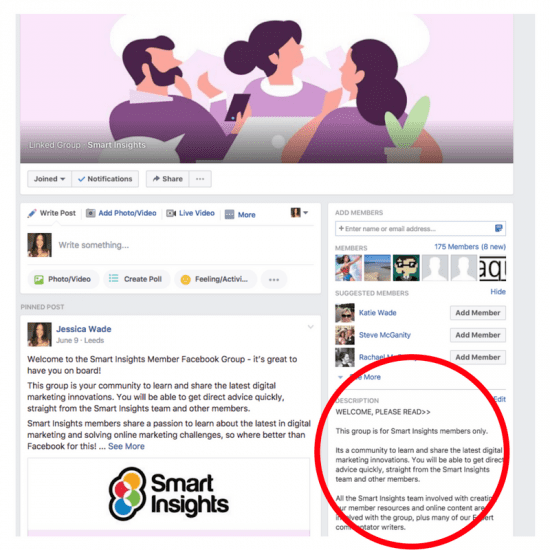The biggest mistake many businesses make is creating a group and then just spamming members with links to their website. This is not what a Facebook group should be about.
Before you consider creating a branded Facebook group, there are a few things you need to know.
First, a group should not replace your business Page but instead, provide another way for your community to find you and engage with you. Also, building an effective group takes time and effort – it’s not a quick solution.
Here are some additional key tips and notes to keep in mind when using Facebook groups to help boost your marketing efforts.
Facebook Groups Versus Facebook Pages
A Facebook Page is for your business, and as such, it makes sense that it’ll be largely self-promotional. A Facebook group, however, should be thought of as a ‘Fan Page’ for your most committed customers, and you should use it as a way to add more value to your product.
Content you share on your business Page has the opportunity to show up in the news feeds of your fans, whereas updates from your Facebook group will only show up in the news feeds of members. Make sure they work in tandem. Actively promote your group to your fans if it’s something they’re able to join – this way, you can leverage your group and your page at the same time
Be sure to promote your group to your fans and have a clear strategy for each platform.
Getting Started
There are three different types of Facebook Groups: ‘public’, ‘closed’ and ‘secret’. Choose the one that best suits your goals and audience.
Facebook Group creation process
Once you’ve decided on the type of group and audience you’re targeting you need to consider content, purpose, and goals.
Here are five tips to help establish your group approach.
1. Provide customer service
Consider using the group to follow-up with your customers and see if they need help or have any questions. This could also be helpful for other followers who have similar questions.
You want to create a place where customers can come to ask a question, and not feel embarrassed to do so. Create a group that’s generous in advice by offering helpful advice and inspire other members to share their insights.
Also, ensure you’re responding to complaints or questions within 24 hours maximum, and responding to them personally. Always thank the customer for asking or flagging an issue and reassure them that you’re working on a resolution.
2. Get feedback
Facebook groups provide a direct line of communication to your target audience. Ask your group what they think of your products and use this feedback to improve your service or product.
If you looking to get feedback on new ideas, or improve the existing ones, Facebook groups are a great source for honest feedback.
3. Avoid self-promotion
One of the most obvious benefits of having your own group is you can control the content and what you post to your followers. But people don’t join groups to be sold to, they look for interesting discussions, industry news and updates.
Look to discuss your expertise and participate in relevant discussions.
4. Keep your group spam-free
One of the most off-putting things about Facebook groups is spam, and it’s the admin’s responsibility to monitor the content appearing in the group and ensure it’s being used for the right purposes. It’s the creator’s job to set and enforce the group rules.
Create a group rules document and upload this into the files section of your group. Also, feature them in your group description.

Stand firm on your spam rules and make sure they are enforced right from the beginning.
5. Look to build a community
Most importantly look to build a community.
When you create a group, you need to remember its not about you – its a place for your customers. You want to provide a place where your members feel comfortable sharing and asking for advice. You need to consider how you can provide value for them by sharing content they will find interesting and helpful.
There’s a lot of opportunities in Facebook groups, with more tools and options being provided to help group admins make best use of the option. If you’ve not considered Facebook groups as a marketing option, it’s worth considering the potential benefits.
More than a billion Facebook users engage within groups every month. That’s a big audience to tap into – for those who can do it right.